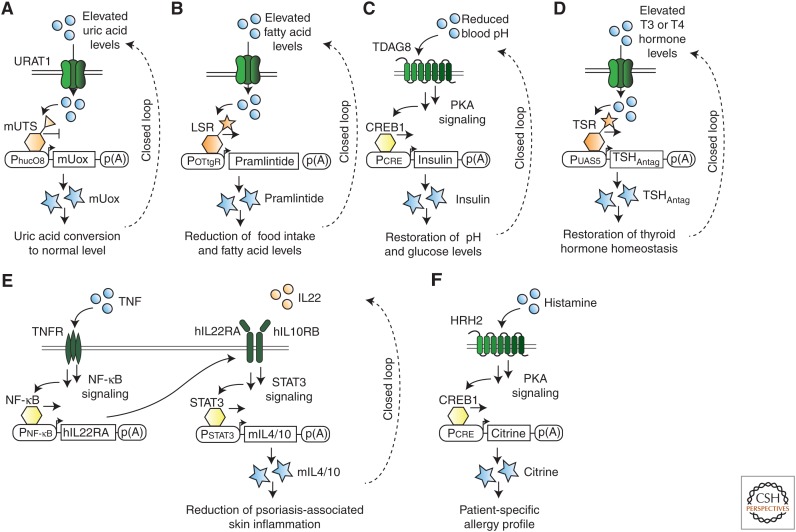Figure 4.
Gene circuits for biomedical applications. (A) Closed-loop gene circuit designed to detect elevated uric acid levels. Uric acid is transported by URAT1 into the cell, where it binds to the engineered uric acid sensor mUTS. This interaction induces the transcription of the secreted enzyme mUox, leading to decreased uric acid levels and thereby closing the gene circuit loop. (B) Closed-loop gene circuit designed to detect elevated fatty acid levels. Fatty acids bind to the engineered fatty acid lipid-sensing receptor (LSR) and induce transcription of the secreted hormone pramlintide, leading to decreased fatty acid levels and thereby closing the gene circuit loop. (C) Closed-loop gene circuit designed to detect decreased blood pH levels. Protons bind to the G protein–coupled receptor (GPCR) TDAG8, triggering a signaling pathway that induces transcription of the secreted hormone insulin. This cascade results in restored blood pH levels, thereby closing the gene circuit loop. (D) Closed-loop gene circuit designed to detect elevated thyroid hormone levels in Graves disease. Thyroid hormones T3 and T4 are transported into the cell and bind the synthetic thyroid-sensing receptor (TSR) that induces transcription of the engineered thyroid-stimulating hormone (TSHAntag) receptor. TSHAntag competes with endogenous TSH receptor for thyroid hormone and autoantibody binding, thereby restoring the thyrotrophic feedback control of the hypothalamus–pituitary–thyroid axis. (E) Antipsoriatic cytokine converter, a closed-loop gene circuit converting the presence of proinflammatory cytokines tumor necrosis factor (TNF) and interleukin 22 (IL22) levels to production of the antiinflammatory cytokines IL4 and IL10 with AND-gate-expression logic. TNF activates the endogenous TNF receptor on the cell surface, and induces the NF-κB signaling pathway. This leads to the expression of the hIL22RA, which heterodimerizes with endogenous hIL10RB to form a functional IL22 receptor. In the presence of IL22, IL22 receptor activates the STAT3 signaling pathway that drives the expression of the secreted, antiinflammatory cytokines mIL4 and mIL10. These cytokines attenuate psoriasis-associated skin inflammations. (F) Gene circuit designed to sense blood-derived histamine. Histamine binds to the GPCR HRH2 and triggers a signaling pathway that induces the transcription of a reporter protein that enables the readout of allergic reactions using engineered mammalian cells. TNFR, Tumor necrosis factor receptor; PKA, protein kinase A.

